Showing Spotlights 977 - 984 of 2798 in category All (newest first):
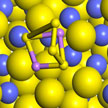 Capacity decay caused by polysulfides' detachment from the cathode framework has been a major issue preventing the broad application of lithium-sulfur (Li-S) batteries. Researchers discovered that it is the incompatibility between polar lithium polysulfide molecules and commonly used nanocarbon cathode scaffolds that restraines the redox reactivity. By incorporating sulfiphilic cobalt disulfide into carbon/sulfur cathodes, They managed to introduce strong interaction between lithium polysulfides and CoS2 under working conditions.
Capacity decay caused by polysulfides' detachment from the cathode framework has been a major issue preventing the broad application of lithium-sulfur (Li-S) batteries. Researchers discovered that it is the incompatibility between polar lithium polysulfide molecules and commonly used nanocarbon cathode scaffolds that restraines the redox reactivity. By incorporating sulfiphilic cobalt disulfide into carbon/sulfur cathodes, They managed to introduce strong interaction between lithium polysulfides and CoS2 under working conditions.
Jan 13th, 2016
 Due to the high concentration of silica in rice husks, most of the present research focuses on the preparation of silicon-based materials, which exhibit broad applications in the fields of adsorption, catalysis, energy storage, etc. There is also a large amount of organic components in rice husks, which is typically wasted in the preparation of these silica materials. Researchers now have developed an advanced method for the comprehensive use of rice husks. They fabricated high quality graphene quantum dots from the organic components of rice husks, and simultaneously obtained mesoporous silica nanoparticles with a high surface area from the inorganic content.
Due to the high concentration of silica in rice husks, most of the present research focuses on the preparation of silicon-based materials, which exhibit broad applications in the fields of adsorption, catalysis, energy storage, etc. There is also a large amount of organic components in rice husks, which is typically wasted in the preparation of these silica materials. Researchers now have developed an advanced method for the comprehensive use of rice husks. They fabricated high quality graphene quantum dots from the organic components of rice husks, and simultaneously obtained mesoporous silica nanoparticles with a high surface area from the inorganic content.
Jan 12th, 2016
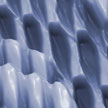 A scientist has discovered a previously unknown three-dimensional nanostructure consisting of graphene sheets. Graphene is a single monolayer of carbon atoms forming a hexagonal two-dimensional crystal lattice. The discovered nanostructure is a multilayer system of parallel hollow channels with quadrangular cross-section extending along the surface. The discovered nanostructure looked so extraordinary that it took some time to understand what it actually was. The structure was dramatically different from whatever had previously been observed on graphite.
A scientist has discovered a previously unknown three-dimensional nanostructure consisting of graphene sheets. Graphene is a single monolayer of carbon atoms forming a hexagonal two-dimensional crystal lattice. The discovered nanostructure is a multilayer system of parallel hollow channels with quadrangular cross-section extending along the surface. The discovered nanostructure looked so extraordinary that it took some time to understand what it actually was. The structure was dramatically different from whatever had previously been observed on graphite.
Jan 11th, 2016
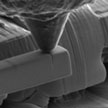 In the past couple of decades, nickel-tungsten (Ni-W) amorphous and nanocrystalline materials have been drawing more and more research interest due to the superior mechanical properties such as high hardness, good mechanical performance, and excellent corrosion resistance. Striving to enhance the mechanical performance of Ni-W thin film alloys, researchers report how the annealing temperature will influence the microstructure evolution and the fracture properties of Ni-W alloys.
In the past couple of decades, nickel-tungsten (Ni-W) amorphous and nanocrystalline materials have been drawing more and more research interest due to the superior mechanical properties such as high hardness, good mechanical performance, and excellent corrosion resistance. Striving to enhance the mechanical performance of Ni-W thin film alloys, researchers report how the annealing temperature will influence the microstructure evolution and the fracture properties of Ni-W alloys.
Jan 8th, 2016
 Metal nanoparticles, when excited at optical frequencies, may experience localized surface plasmon resonances, which determine enhanced local electric fields, increased scattering cross sections, and high sensitivity to the environment refractive index. Thanks to these unique properties, they are widely utilized especially in biomedical sciences and engineering. Researchers have now conceived and demonstrated a new method to fully automate the design of metal nanoparticles.
Metal nanoparticles, when excited at optical frequencies, may experience localized surface plasmon resonances, which determine enhanced local electric fields, increased scattering cross sections, and high sensitivity to the environment refractive index. Thanks to these unique properties, they are widely utilized especially in biomedical sciences and engineering. Researchers have now conceived and demonstrated a new method to fully automate the design of metal nanoparticles.
Jan 7th, 2016
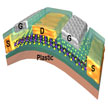 In the past, the performance of synthesized MoS2 had been poor, especially when integrated on flexible substrates. A new study have now yielded the highest performance for CVD-grown monolayer MoS2 device properties on flexible substrates to date. MoS2 exhibits unique physical, optical and electrical properties correlated with its single-layer atomic layer structure. Important for electronics applications, and in contrast to graphene, MoS2 has a bandgap.
In the past, the performance of synthesized MoS2 had been poor, especially when integrated on flexible substrates. A new study have now yielded the highest performance for CVD-grown monolayer MoS2 device properties on flexible substrates to date. MoS2 exhibits unique physical, optical and electrical properties correlated with its single-layer atomic layer structure. Important for electronics applications, and in contrast to graphene, MoS2 has a bandgap.
Jan 6th, 2016
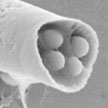 The goal of a vast amount of nanomedicine research is the perfect drug carrier: it is injected into the body and transports itself to the correct target, such as a tumor, and delivers the required therapeutic drug dose at this target. This idealized concept was first proposed at the beginning of the 20th century and was nicknamed the 'magic bullet' concept. Taking this 'bullet' concept literally, researchers have developed acoustically triggered microcannons, capable of versatile loading and effective firing of nanobullets, as novel tools toward advancing microscale tissue penetration of therapeutic payloads.
The goal of a vast amount of nanomedicine research is the perfect drug carrier: it is injected into the body and transports itself to the correct target, such as a tumor, and delivers the required therapeutic drug dose at this target. This idealized concept was first proposed at the beginning of the 20th century and was nicknamed the 'magic bullet' concept. Taking this 'bullet' concept literally, researchers have developed acoustically triggered microcannons, capable of versatile loading and effective firing of nanobullets, as novel tools toward advancing microscale tissue penetration of therapeutic payloads.
Jan 5th, 2016
 Engineered nanoparticles are being used in a wide range of product areas, including composite materials, coatings, electronics, food, agriculture, cosmetics, healthcare, and biotechnology. As a consequence, human exposure to nanoparticles has become a prominent environmental concern; especially since these potential pollutants are not visible to the human eye or detectable by smell. However, there is no current technology that provides rapid, sensitive and highly portable detection and identification of nanoparticles. Now though, researchers have developed a simple colorimetric sensor array approach capable of detection and unambiguous differentiation of a wide range of nanoparticles in aqueous solutions.
Engineered nanoparticles are being used in a wide range of product areas, including composite materials, coatings, electronics, food, agriculture, cosmetics, healthcare, and biotechnology. As a consequence, human exposure to nanoparticles has become a prominent environmental concern; especially since these potential pollutants are not visible to the human eye or detectable by smell. However, there is no current technology that provides rapid, sensitive and highly portable detection and identification of nanoparticles. Now though, researchers have developed a simple colorimetric sensor array approach capable of detection and unambiguous differentiation of a wide range of nanoparticles in aqueous solutions.
Jan 4th, 2016
 Capacity decay caused by polysulfides' detachment from the cathode framework has been a major issue preventing the broad application of lithium-sulfur (Li-S) batteries. Researchers discovered that it is the incompatibility between polar lithium polysulfide molecules and commonly used nanocarbon cathode scaffolds that restraines the redox reactivity. By incorporating sulfiphilic cobalt disulfide into carbon/sulfur cathodes, They managed to introduce strong interaction between lithium polysulfides and CoS2 under working conditions.
Capacity decay caused by polysulfides' detachment from the cathode framework has been a major issue preventing the broad application of lithium-sulfur (Li-S) batteries. Researchers discovered that it is the incompatibility between polar lithium polysulfide molecules and commonly used nanocarbon cathode scaffolds that restraines the redox reactivity. By incorporating sulfiphilic cobalt disulfide into carbon/sulfur cathodes, They managed to introduce strong interaction between lithium polysulfides and CoS2 under working conditions.
 Subscribe to our Nanotechnology Spotlight feed
Subscribe to our Nanotechnology Spotlight feed





